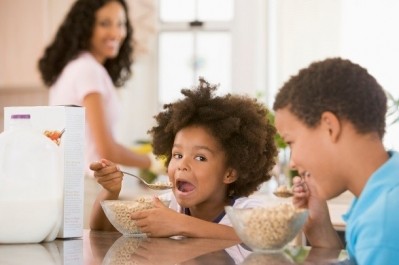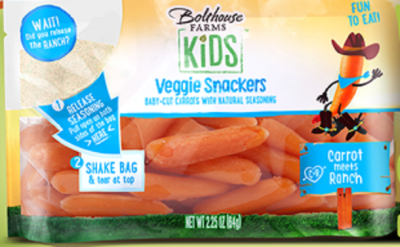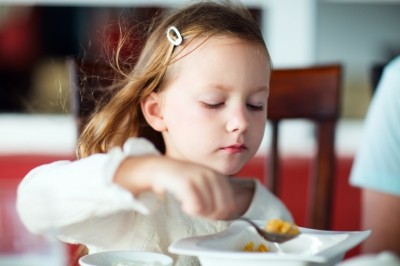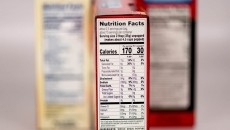Cartoon characters could help children embrace fruits & veggies, study finds
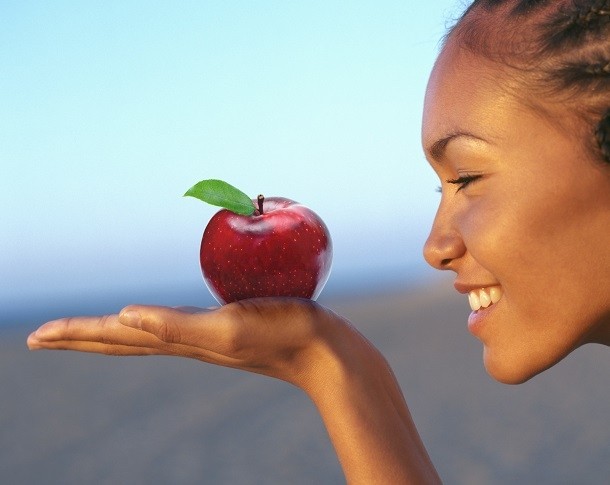
Researchers from the University of Bari Adlo Moro in Italy found preschoolers were more likely to select kiwis, carrots and tomatoes as tastier snacks than crackers, croutons and biscuits when the produce featured a sticker with a cartoon character.
Even the 5- to 6-year-olds who typically refused to eat fruit and vegetables opted for the produce with their favorite character instead of less healthy, but familiar, name brand snacks that they typically ate, according to the study, which was published in December in the International Journal of Markets and Business Systems.
“The findings show that characters deeply influenced children’s choices in favor of healthy food,” and “can represent an incisive marketing tool to increase children’s appreciation of fruit and vegetables,” the authors write.
How characters sell products
They explain that the stickers helped children overcome a perceived dislike of fruit and vegetables or a fear of a new food by so enchanting them that they linked the aesthetic appearance of the character with the good taste of the selected foods – even if they hadn’t tried the food before.
Similarly, the character stickers caught and held the children’s attention to the point that they overlooked all other details – including the less healthy snack options.
While the finding that cartoons attract children's attention may seem obvious given the broad use of the marketing tactic by less nutritious foods, it is notable because the strategy rarely is used on produce or healthy children’s foods.
Rather, produce typically is marketed to adults, who then have the sometimes challenging task of convincing children to eat it. This could result in parents hiding the fruit and vegetables in more desirable foods, which does not teach children to like produce and can hinder the development of healthy eating patterns later in life. The other common option is parents simply do not buy the fruit and vegetables for their children.
Targeting children could help firms reach parents
By turning marketing efforts for produce around – and targeting children rather than adults – companies could capture more adult’s attention as well, the researchers suggest.
“It cannot be denied that nowadays children play a more decisive role in family purchasing decisions compared to the past,” and using spokescharacters to sell fruit and vegetables “creates new opportunities for enterprises” to reach adults through their children, they write.
Real world examples
Marketing by True Drinks for the flavored water AquaBall already embraces this strategy and demonstrates how successfully the study’s findings can be applied to healthy children’s products. Sales of the water have grown quickly thanks in part to the licensed Disney characters on its packaging, the company CEO previously told FoodNavigator-USA. He notes that the characters appeal to children and make them avid endorsers of the product.
Bolthouse Farms also uses this tactic to sell bags of baby carrots, smoothies and fruit tubes for children. The packages feature fruits and veggies with arms, legs and even hats and boots to create characters that appeal to children. By directly incorporating the produce image into the character, the company creates a positive association with the food.
Other manufacturers that want to use this strategy should note that different variables, such as children’s age, can affect how youngsters react to characters, the study authors note. Thus, they suggests, selecting characters that are “most popular from the point of view of a particular period.”
Limitations
While previous research reinforces the current study’s finding, the authors caution that several factors could limit the results.
Mainly, the study was small – including only 13 children – and the preschoolers selected the “tastiest” snack in front of each other, so they could have been influenced by their peers’ answers.
Also, the children were not able to eat the food they chose. Rather, they were instructed simply to select their favorite food from the options provided (tomatoes, carrots, kiwis, crackers, croutons and biscuits) to help create a “potion” to save a frog in a fairy tale they were told as part of the study’s “gamification.”
With this in mind, the researchers suggest larger future studies that are more quantitative to better understand how food marketing can help improve children’s diets.
